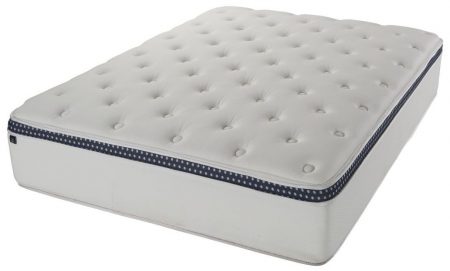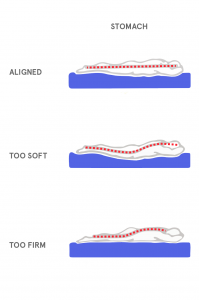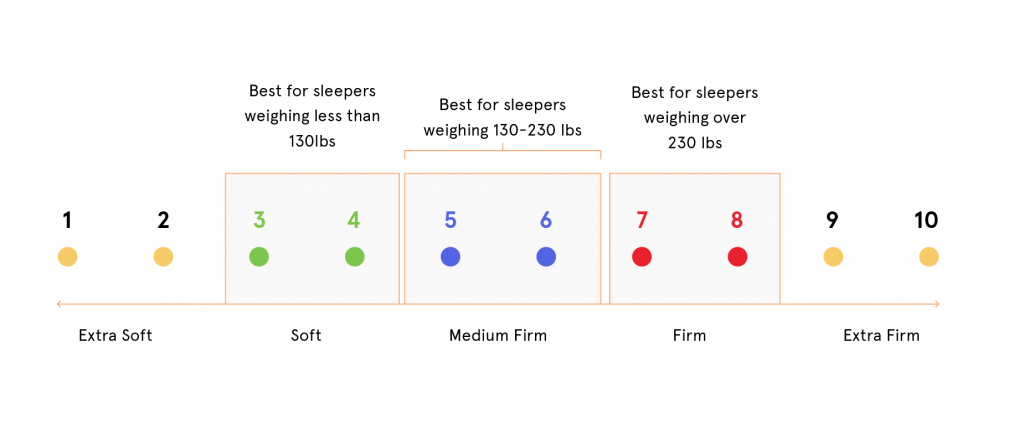Choosing the Best Mattress for Stomach Sleeping
 A supportive mattress can make a world of difference to a stomach sleeper. When discussing mattresses, ‘support’ refers to the flatness and evenness of the sleep surface. A supportive mattress will conform to the sleeper’s body and help align the spine without sinking too deeply, which creates an uneven surface.
A supportive mattress can make a world of difference to a stomach sleeper. When discussing mattresses, ‘support’ refers to the flatness and evenness of the sleep surface. A supportive mattress will conform to the sleeper’s body and help align the spine without sinking too deeply, which creates an uneven surface.
The Best Firmness Level for Stomach Sleepers
The stomach sleeper’s body weight and the firmness of the mattress both play a role in supportiveness. Firmness is assigned on a 1 to 10 scale, with ‘1’ being the least firm and ’10’ being the firmest. Most mattresses sold today fall between a ‘3’ (or ‘Soft’) and an ‘8’ (or ‘Extra Firm’). Generally, stomach sleepers find a mattress on the firmer end of that scale to be more comfortable. This prevents their midsection from sinking too deeply, thereby pulling their spine out of alignment and resulting in pain in the lower back.
Stomach sleepers who weigh between 130 and 230 pounds tend to prefer a ‘5’ (‘Medium’) or ‘6’ (‘Medium Firm’). These mattresses conform to a degree but do not sink deeply and provide even, adequate support.
Firmness preferences may vary for those who weigh less than 130 pounds and those who weigh more than 230 pounds. Lightweight individuals may find a slightly softer mattress to be more comfortable, while heavier individuals will need a higher level of firmness to prevent sinking into the mattress. The table below explores different firmness preferences for stomach sleepers in all three weight groups.
The diagram below illustrates the most common firmness preferences among stomach sleepers in all three weight groups.

Which Types of Mattresses Are Best for Stomach Sleepers?
As we’ve discussed above, aches and pains are commonly associated with stomach sleeping regardless of mattress choice. However, some models are better equipped to accommodate stomach sleepers than others due to the material composition of their comfort layers and support cores, most notably foam and hybrid beds. In addition to supportiveness, mattress types also vary in terms of temperature neutrality, noise, odor potential, durability, and price-point.
Below we provide an overview of the five most common mattress types you’ll encounter today, along with their suitability for stomach sleepers.
Best Foam Beds for Stomach Sleepers
Mattress Reviews
Nectar Mattress Review
Foam mattresses are made entirely of foam, with support layers of polyfoam and comfort layers of polyfoam or memory foam. Foam mattress manufacturers will indicate the density and the ILD of the foams used in each layer of the mattress.
This can all get a bit technical, but here’s what stomach sleepers need to know:
- The density of a foam roughly describes how well the foam can support your body weight. Higher-density foams offer more contouring and retain their shape very slowly. They also tend to trap more body heat.
- ILD, on the other hand, describes how soft or firm the foam is: lower ILD ratings (8 to 10) are very soft, while higher ILD ratings (16 to 21) are less soft.
Because stomach sleepers generally require a firmer mattress to enjoy healthy spinal alignment, foams with higher density and higher ILD ratings are better. Higher ILD ratings are particularly important for heavier stomach sleepers, in order to avoid sinking into the mattress surface.
With a sufficiently firm rating, foam mattresses can be particularly comfortable for stomach sleepers, providing enough conforming to cradle the body’s pressure points while supporting proper spinal alignment.
However, they’re not recommended for hot sleepers, as all that conforming can cause these beds to trap body heat. Firmer foam mattresses, along with those that use cooling gel or copper in their comfort layers (like our Best Value pick, the Nectar, does), can be a good workaround for this issue.
Innerspring mattresses use a uniform grid of innerspring steel coils as their support system, topped by comfort layers of foam. Stomach sleepers can enjoy these beds for their consistent, even support.
However, the level of conforming these mattresses can offer depends largely on the composition and thickness of their comfort layers. With thinner comfort layers, the sleeper may feel too much as if they are lying “on” the mattress; heavier parts of their body may not sink deep enough to keep the spine straight and prevent aches and pains.
Innerspring mattresses can also be less durable than other mattress types, and develop sagging within a number of years—especially if the sleeper has a heavier body type or if the mattress is constructed from lower-quality materials.
Hybrid mattresses combine features of foam and innerspring beds. They feature a support layer of individually pocketed steel coils, reinforced with a base and surrounding layers of polyfoam. On top, the comfort layers will include at least 2 inches of latex or memory foam, with potentially other materials like polyfoams or minicoils.
Hybrid mattresses can be ideal for stomach sleepers. Their pocketed coil layer ensures consistent, even support, with some contouring to adequately support heavier parts of the body. Many of these beds, like the Awara mattress and the WinkBed Plus, actually leverage a zoned design with the support layer, specifically designed to provide stronger support for those areas.
And because hybrid mattresses feature at least a few inches in their comfort layers, these beds also ensure stomach sleepers enjoy enough cushioning to feel comfortable while they sleep.
Hybrid mattresses also offer the additional benefits of sleeping fairly cool (thanks to airflow throughout the coil core), providing good pressure and pain relief, and maintaining enough responsiveness to be suitable for sex.
Latex mattresses are made of natural or synthetic latex, or a blend of the two. As with foam beds, these mattresses will use different types of latex foams for support or comfort. While not always the case, it’s more common to see Dunlop latex in the support layers, as this latex has a denser feel, with fluffier Talalay latex in the comfort layers.
However, as we saw with the WinkBed Plus, our latex hybrid choice for heavier stomach sleepers, Dunlop latex can also be used in the comfort layers. Dunlop latex generally can be preferred among stomach sleepers, due to its denser, heavier feel. It also tends to be more resilient and resistant to sagging, an important consideration for stomach sleepers.
Overall, latex mattresses have a unique feel and elastic-like quality that some sleepers enjoy. These mattresses tend to sleep quite cool, especially if they’re made entirely or mostly from organic latex, and they have one of the longest lifespans of all the mattress types.
Airbeds use air as their support system, with individual chambers of air that can be filled or deflated according to the sleeper’s preference. Sleepers can adjust the firmness of the bed themselves, either using a manual hand crank or by remote control. This is a large reason why these beds are popular among their loyalists.
Some people have shifting firmness preferences, whether due to a change in body weight or a physical injury, and being able to adjust the firmness of their bed without having to buy a whole new mattress is perceived as a large benefit. These beds can also be very durable and last for a number of years, as long as they are maintained well and the individual parts are replaced as needed.
However, airbeds do tend to have thinner comfort layers and provide minimal conforming. As a result, some stomach sleepers may need to buy a mattress topper to make these beds sufficiently comfortable.
The table below summarizes notable pros and cons of the five most common mattress types, and explains which are most suitable for stomach sleeping.
Match Your Pillows & Bedding
As we discussed above, maintaining healthy spinal alignment while you sleep is essential to enjoying a restful night, and a pain-free morning. For stomach sleepers, the first step toward that goal is the right mattress. The second step is the right pillow.
Choosing the right pillow is an especially important decision for stomach sleepers, and in some ways a surprising one. Here’s the surprise: many stomach sleepers actually sleep better without a pillow.
Without a pillow, your spine has an easier job lying flat from your pelvis all the way through your neck and head. Many people choose a pillow with too much loft, or pillow height, which causes their necks to tilt back and up as they turn them to the side. As you can imagine, this can result in neck and back pain for stomach sleepers.
One way around this issue is to sleep without a pillow. If your mattress has sufficiently cushiony comfort layers, as many foam and hybrid beds do, this is no problem. The top comfort layers of the mattress conform closely to the head and neck, cradling them just like a pillow would.
Pillow Loft & Materials
For some stomach sleepers, however, it’s difficult to get used to sleeping without a pillow – and that’s okay. If you’re one of these folks, simply opt for a lower-loft pillow that gives you the comfort you seek without creating an uncomfortable curvature in your neck or upper spine. A low- or medium-loft pillow, between 2 to 5 inches, is a good choice.
Additionally, many stomach sleepers choose pillows with adjustable loft. These allow you to adjust the height of the pillow by unzipping the cover and adding or removing the fill material. Adjustable pillows can also help sleepers transition from sleeping with a pillow to without one, as they can gradually remove fill from the pillow until they no longer need it.
Speaking of pillow fill, there are many options for stomach sleepers to choose from. Typically, stomach sleepers find down and memory foam pillows to be the most supportive. Both are available in thin, lower-loft varieties, as well as adjustable lofts. They’re also quite soft, allowing your head to sink deep enough to keep the neck straight.
Additional Body Pillows for Stomach Sleepers
Beyond their head pillow, stomach sleepers can use additional pillows to support spinal alignment while they sleep. You may wish to experiment with either or both of the following pillow positions:
- Place a thin pillow beneath your pelvis to relieve pressure on your lower back and stomach.
- Use a thin pillow beneath the shoulders to help fill in the gap between the neck and the mattress surface, and reduce pressure on the shoulders and upper spine.
Mattress Buying Tips for Stomach Sleepers
After deciding which mattress type is most suitable for your and your partner’s needs, the only step that remains is ordering and purchasing the mattress. Here are a few tips to guide you through this last important step.





 Fewer than 10% of adults in the U.S. sleep on their stomachs
Fewer than 10% of adults in the U.S. sleep on their stomachs A supportive mattress can make a world of difference to a stomach sleeper. When discussing mattresses, ‘support’ refers to the flatness and evenness of the sleep surface. A supportive mattress will conform to the sleeper’s body and help align the spine without sinking too deeply, which creates an uneven surface.
A supportive mattress can make a world of difference to a stomach sleeper. When discussing mattresses, ‘support’ refers to the flatness and evenness of the sleep surface. A supportive mattress will conform to the sleeper’s body and help align the spine without sinking too deeply, which creates an uneven surface. 